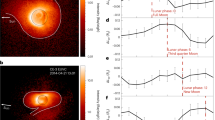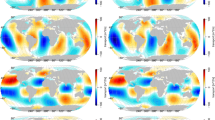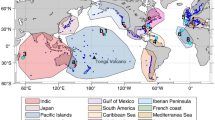Abstract
THE rate at which tidal energy is dissipated in the solid Earth can constrain the anelastic properties of the Earth at frequencies much lower than those accessible with seismology. The dissipative properties of a system are usually expressed as a 'quality factor', Q; estimates1–7 of the semi-diurnal solid-Earth Q range from 90 to 500. But observational constraints on this quantity are difficult to obtain, because dissipation by the body tide is masked by the much greater dissipation that occurs in the oceans8,9. Here we show that recent accurate measurements of the ocean tide obtained by the Topex/Poseidon satellite altimeter10, combined with nearly two decades of laser tracking of satellite orbit perturbations11 (which are sensitive to the total planetary dissipation rate), permit an estimate of the solid-Earth dissipation rate at semi-diurnal period. We find that the body tide lags the principal lunar tidal potential by 0.16±0.09°, implying a dissipation rate of 83±45 gigawatts and a solid-Earth Q of 370 at a period of 12.4 hours. The observed lag agrees well with Zschau's 'most probable' lag1 of 0.21° (deduced from observations of the Chandler wobble), and favours the higher values of Q estimated theoretically.
This is a preview of subscription content, access via your institution
Access options
Subscribe to this journal
Receive 51 print issues and online access
$199.00 per year
only $3.90 per issue
Buy this article
- Purchase on Springer Link
- Instant access to full article PDF
Prices may be subject to local taxes which are calculated during checkout
Similar content being viewed by others
References
Zschau, J. in Space Geodesy and Geodynamics (eds Anderson, A. & Cazenave, A.) 315–344 (Academic, London, 1986).
Lagus, P. L. & Anderson, D. L. Phys. Earth planet Inter. 1, 505–510 (1968).
Bostrom, R. C. EOS 76, F60 (1995).
Munk, W. Q. Jl R. astr. Soc. 9, 352–375 (1968).
Tanimoto, T. Geophys. Res. Lett. 17, 669–672 (1990).
Wahr, J. & Bergen, Z. Geophys. J. R. astr. Soc. 87, 633–668 (1986).
Dehant, V. Phys. Earth planet. Inter. 49, 97–116 (1987).
Lambeck, K. Phil. Trans. R. Soc. Lond. A287, 545–594 (1977).
Ray, R. D. in The Oceans (eds. Majumdar, S. K. et al.) 171–185 (Pennsylvania Academy of Science, Easton, 1994).
Fu, L.-L. et al. J. geophys. Res. 99, 24369–24381 (1994).
Cohen, S. C. & Smith, D. E. J. geophys. Res. 90, 9217–9220 (1985).
Munk, W. H. & MacDonald, G. J. F. The Rotation of the Earth (Cambridge Univ. Press, 1960).
Platzman, G. W. Rev. Geophys. Space Phys. 22, 73–84 (1984).
Cartwright, D. E. & Ray, R. D. J. geophys. Res. 96, 16897–16912 (1991).
Schrama, E. J. O. & Ray, R. D. J. geophys. Res. 99, 24799–24808 (1994).
Marshall, J. A. et al. J. geophys. Res. 100, 25331–25352 (1995).
Le Provost, C., Bennett, A. F. & Cartwright, D. E. Science 267, 639–642 (1995).
Andersen, O. B., Woodworth, P. L. & Flather, R. A. J. geophys. Res. 100, 25261–25282 (1995).
Lerch, F. Bull. Géod. 65, 44–52 (1991).
Wunsch, C. & Stammer, D. J. geophys. Res. 100, 24895–24910 (1995).
Haurwitz, B. & Cowley, A. D. Pure appl. Geophys. 102, 193–222 (1973).
Platzman, G. W. Pure Appl. Geophys. 137, 1–33 (1991).
Zschau, J. in Tidal Friction and the Earth's Rotation (eds Brosche, P. & Sündermann, J.) 62–94 (Springer, New York, 1978).
Pagiatakis, S. D. Geophys. J. Int. 103, 541–560 (1990).
Ray, R. D., Sanchez, B. & Cartwright, D. E. EOS 75, 108 (1994).
Eanes, R. J. EOS 75, 108 (1994).
Lerch, F. J. et al. NASA Tech. Memo. 104555 (Goddard Space Flight Center, Greenbelt, 1992).
Tapley, B. D., Schutz, B. E., Eanes, R. J., Ries, J. C. & Watkins, M. M. in Cotnributions of Space Geodesy to Geodynamics: Earth Dynamics (eds Smith, D. E. & Turcotte, D.) 147–174 (Am. geophys. Union, Washington, 1993).
Gill, A. Atmosphere-Ocean Dynamics (Academic, New York, 1982).
Le Provost, C., Genco, M. L., Lyard, F., Vincent, P. & Canceil, P. J. geophys. Res. 99, 24777–24797 (1994).
Schwiderski, E. W. Mar. Geol. 6, 219–265 (1983).
Parke, M. E. & Hendershott, M. C. Mar. Geol. 3, 379–407 (1980).
Author information
Authors and Affiliations
Rights and permissions
About this article
Cite this article
Ray, R., Eanes, R. & Chao, B. Detection of tidal dissipation in the solid Earth by satellite tracking and altimetry. Nature 381, 595–597 (1996). https://doi.org/10.1038/381595a0
Received:
Accepted:
Issue Date:
DOI: https://doi.org/10.1038/381595a0
This article is cited by
-
Sensitivity analysis of polar orbiter motion to lunar viscoelastic tidal deformation
Celestial Mechanics and Dynamical Astronomy (2023)
-
Quantification of tidal parameters from Solar System data
Celestial Mechanics and Dynamical Astronomy (2016)
-
Two types of co-accretion scenarios for the origin of the Moon
Earth, Planets and Space (2014)
-
Tidal synchronization of close-in satellites and exoplanets. A rheophysical approach
Celestial Mechanics and Dynamical Astronomy (2013)
-
Observational evidences for the speed of the gravity based on the Earth tide
Chinese Science Bulletin (2013)
Comments
By submitting a comment you agree to abide by our Terms and Community Guidelines. If you find something abusive or that does not comply with our terms or guidelines please flag it as inappropriate.



